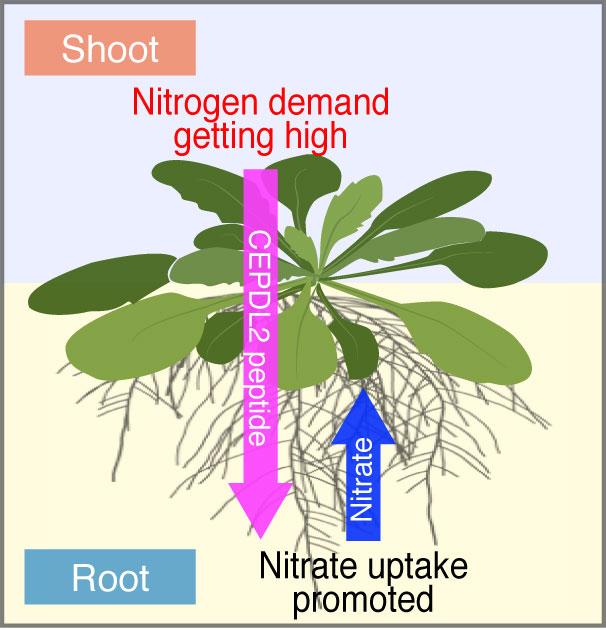Scientists identify a hormone produced in nitrogen-starved leaves that stimulates roots to take up nitrogen from soil

Credit: Yoshikatsu Matsubayashi, Nagoya University
Nagoya University researchers have found that in response to the nitrogen demand of leaves, plants produce a hormone that travels from the leaves to the roots to stimulate the uptake of nitrogen from the soil. This hormone is produced in the leaves when they run short of nitrogen, and acts as a signal that regulates the demand and supply of nitrogen between the plant’s shoot and the root. The findings have recently been published online in the journal Nature Communications.
Nitrogen is an essential nutrient for plant growth and is very important for crop production. However, often too much nitrogen fertilizer is used, leading to contamination of the environment and rising food prices. What if plants could be made to regulate their own intake of nitrogen more effectively?
Nagoya University researchers have found the key to doing this. “By enhancing the pathway of this hormone, plants could be able to absorb nitrogen nutrients more efficiently, which may eventually minimize the use of fertilizers,” says Professor Yoshikatsu Matsubayashi of the Graduate School of Science at Nagoya University.
Plant roots take up nitrogen nutrients in the form of nitrate from the soil — how much nitrogen a plant needs depends on the shoot growth stage. The larger and more numerous the leaves and stems become, the more nitrogen a plant needs.
The research team studied how plant roots sense nitrogen demand in the shoots. A previous study using a plant called Arabidopsis (better known as thale cress) had shown that certain hormones, named C-terminally encoded peptide (CEP) and CEP downstream (CEPD), respectively, modulate communications between the nitrogen-starved roots and other roots via leaves. The previous study had also revealed that plants produce other hormones that are structurally similar to CEPD.
In the new study, Prof. Matsubayashi and colleagues also focused on these hormones in Arabidopsis, analyzing each of their functions and thereby identifying a peptide that can strongly promote the absorption of nitrogen. The peptide, named CEP downstream-like 2 (CEPDL2), was present in leaf veins and would be produced rapidly in large amounts when the leaf ran short of nitrogen. Simultaneously, the CEPDL2 peptide would flow from shoot to roots.
In contrast, the researchers demonstrated that on plants where the CEPDL2 peptide had been destroyed, leaves were still small in the later growth period when the shoot requires a lot of nitrogen. “This means the plant cannot grow properly without this peptide, showing that the CEPDL2 peptide is the signal that regulates the balance of demand and supply between leaves and roots,” Prof. Matsubayashi says. “Our findings highlight one extraordinary way in which plants sense and adapt to changing conditions.”
###
The article, “Shoot-to-root mobile CEPD-like 2 integrates shoot nitrogen status to systemically regulate nitrate uptake in Arabidopsis,” was published online in the journal Nature Communications on January 31, 2020, at DOI: 10.1038/s41467-020-14440-8.
This research was supported by a Grant-in-Aid for Scientific Research (S) (No. 18H05274) and a Grant-in-Aid for Scientific Research on Innovative Areas (No. 15H05957) from the Japan Society for the Promotion of Science.
For more information, contact:
Yoshikatsu Matsubayashi
Professor, Graduate School of Science, Nagoya University
Email: [email protected]
About Nagoya University, Japan
Nagoya University has a history of about 150 years, with its roots in a temporary medical school and hospital established in 1871, and was formally instituted as the last Imperial University of Japan in 1939. Although modest in size compared to the largest universities in Japan, Nagoya University has been pursuing excellence since its founding. Six of the 18 Japanese Nobel Prize-winners since 2000 did all or part of their Nobel Prize-winning work at Nagoya University: four in Physics – Toshihide Maskawa and Makoto Kobayashi in 2008, and Isamu Akasaki and Hiroshi Amano in 2014; and two in Chemistry – Ryoji Noyori in 2001 and Osamu Shimomura in 2008. In mathematics, Shigefumi Mori did his Fields Medal-winning work at the University. A number of other important discoveries have also been made at the University, including the Okazaki DNA Fragments by Reiji and Tsuneko Okazaki in the 1960s; and depletion forces by Sho Asakura and Fumio Oosawa in 1954.
Media Contact
Yoshikatsu Matsubayashi
[email protected]
Original Source
http://en.
Related Journal Article
http://dx.




